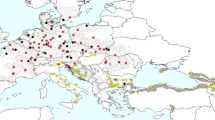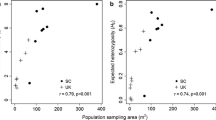Abstract
Coincya monensis is represented in the British flora by two, cytologically distinct subspecies. Coincya monensis ssp monensis is an endemic diploid with a coastal sand dune distribution that includes a number of isolated populations. Coincya monensis ssp cheiranthos is a tetraploid alien, well established in South Wales in early successional habitats. Both subspecies share similar life form traits, flowering times and pollinators. Cluster analysis and phylogenetic reconstruction based on sequences of the mitochondrial nad4 gene confirmed the distinction between alien and endemic taxa. Tetraploid populations carry more polymorphic RAPDs loci and their genetic diversity is partitioned more within than among populations. In contrast, C. monensis ssp monensis has a distinct population genetic structure. Analysis of the multilocus genetic data confirmed a structure of genetically isolated, endemic population clusters in Scotland, Arran, the Isle of Man and South Wales. Experimental hybridisation showed the two subspecies are interfertile. Multivariate analysis of RAPDs data resolved hybrids between alien and endemic clusters and hybrids contained a proportion of alien-specific polymorphic loci. Hybrids of alien maternal parentage contained the mitochondrial nad4 sequence characteristic of the alien subspecies. Since the alien subspecies can invade mobile sand dune communities from urban sites and compete for pollinators, there is a risk that alien and endemic populations will mix and introgress. Conservation of endemic genetic diversity in Britain will require protection for all C. monensis ssp monensis populations. Currently, the most disjunct endemic population in South Wales is most at risk from introgression.






Similar content being viewed by others
References
Abbot RJ (1992) Plant invasions, interspecific hybridisation and the evolution of new plant taxa. Trends Ecol Evol 7:401–405
Ayres DR, Garcia-Rossi D, Davis HG, Strong DR (1999) Extent and degree of hybridisation between exotic (Spartina alterniflora) and native (S. foliosa) cordgrass (Poaceae) in California, USA determined by random amplified polymorphic DNA (RAPDs). Mol Ecol 8:1179–1186
Bennett A (1906) Supplement to topographical botany. West, Neweman & Co., London
Bussell JD (1999) The distribution of random amplified polymorphic DNA (RAPD) diversity amongst populations of Isotoma petraea (Lobeliaceae). Mol Ecol 8:775–789
Cardoso MA, Provan J, Powell W, Ferreira PCG, De Oliveira DE (1998) High genetic differentiation among remnant populations of the endangered Caesalpinia echinata Lam. (Leguminosae-Caesalpinioideae). Mol Ecol 7:601–608
Compton SG, Key RS (2000) Coincya wrightii (O.E. Schulz) Stace (Rhyncosinapis wrightii (O.E. Schulz) Dandy ex A. R. Clapham). J Ecol 88:535–547
Ellstrand NC, Schierenbeck KA (2000) Hybridisation as a stimulus for the evolution of invasiveness in plants? Proc Nat Acad Sci 97:7043–7050
Excoffier L, Smouse P, Quattro J (1992) Analysis of molecular variance inferred from metric distances among DNA haplotypes: application to human mitochondrial DNA restriction data. Genetics 131:479–491
Falush D, Stephens M, Pritchard JK (2003) Inference of population structure using multilocus genotype data: linked loci and correlated allele frequencies. Genetics 164:1567–1587
Gonzalez-Astorga J, Castillo-Campos G (2004) Genetic variability of the narrow endemic tree Antirhea aromatica Castillo-Campos & Lorence, (Rubiaceae, Guettardeae) in a tropical forest of Mexico. Ann Bot 93:521–528
Heslop-Harrison J, Heslop-Harrison Y, Shivanna KR (1984) The evaluation of pollen quality, and a further appraisal of the fluorochromatic (FCR) test procedure. Theor Appl Genet 67:367–375
Hipkin C (2003) Putting our alien flora into perspective. Brit Wildlife 14:413–422
Hollingsworth ML, Hollingsworth PM, Jenkins GI, Bailey JP, Ferris C (1998) The use of molecular markers to study patterns of genotypic diversity in some invasive alien Fallopia spp. (Polygonaceae). Mol Ecol 7:1681–1691
Huxel GR (1999) Rapid replacement of native species by invasive species: effects of hybridisation. Biol Conserv 89:143–152
Isabel N, Beaulieu J, Theriault P, Bousquet J (1999) Direct evidence for biased gene diversity estimates from dominant random amplified polymorphic DNA (RAPD) fingerprints. Mol Ecol 8:477–483
Jensen JL, Bohonak AJ, Kelley ST (2005) Isolation by distance, web service. BMC Genetics 6:13 http://phage.sdsu.edu/∼jensen/
Leadlay EA, Heywood VH (1990) The biology and systematics of the genus Coincya Porta & Rigo ex Rouy (Cruciferae). Bot J Linn Soc 102:313–398
Lee PLM, Patel RM, Conlan RS, Wainwright SJ, Hipkin CR (2004) Comparison of genetic diversities in native and alien populations of Hoary Mustard (Hirschfeldia incana (L.) Lagreze-Fossat). Int J Plant Sci 165:833–843
Lewontin RC (1972) Apportionment of human diversity. Evol Biol 6:381–398
Lynch M, Milligan BG (1994) Analysis of population genetic structure with RAPD markers. Mol Ecol 3:91–99
Manchester SJ, Bullock JM (2000) The impacts of non-native species on UK biodiversity and the effectiveness of control. J Appl Ecol 37:845–864
Mantel N (1967) The detection of disease clustering and generalized regression approach. Cancer Res 27:209–220
Milne RI, Abbot RJ (2000) Origin and evolution of invasive naturalized material of Rhododendron ponticum L. in the British Isles. Mol Ecol 9:541–556
Nybom H (2004) Comparison of different nuclear DNA markers for estimating intraspecific genetic diversity in plants. Mol Ecol 13:1143–1155
Nybom H, Bartish IV (2000) Effects of life history traits and sampling strategies on genetic diversity estimates obtained with RAPD markers in plants. Perspect Plant Ecol Evol Syst 3/2:93–114
Persson Hovmalm HA, Jeppsson N, Bartish IV, Nybom H (2004) RAPD analysis of diploid and tetraploid populations of Aronia points to different reproductive strategies within the genus. Hereditas 141:301–312
Preston CD, Hill MO (1997) The geographical relationships of the British and Irish vascular plants. Bot J Linn Soc 124:1–120
Preston CD, Pearman DA, Dines TD (2002) New atlas of the British & Irish flora. Oxford University Press, Oxford
Pritchard JK, Stephens M, Rosenburg NA, Donnelly P (2000) Inference of population structure using multilocus genotype data. Genetics 155:945–959
Ramsey J, Schemske DW (1998) Pathways, mechanism, and rates of polyploidy formation in flowering plants. Ann Rev Ecol Sys 29:467-501
Randell RA, Howarth DG, Morden CW (2004) Genetic analysis of natural hybrids between endemic and alien Rubus (Rosaceae) species in Hawaii. Conserv Genet 5:217–230
Reisch C, Poschlod P, Wingender R (2003) Genetic variation of Saxifraga paniculata Mill. (Saxifragaceae): molecular evidence for glacial relict endemism in central Europe. Biol J Linn Soc 80:11–21
Rhymer J, Simberloff D (1996) Extinction by hybridisation and introgression. Annu Rev Ecol Syst 27:83–109
Rich TCG (1991) Crucifers of Great Britain and Ireland. B.S.B.I. Handbook 6:Botanical Society of the British Isles, London
Rich TCG (1999) The potential for seed dispersal by sea water in Coincya wrightii (O. E. Schulz) Stace and C. monensis (L.) W. Greuter & Burdet subsp. monensis. Watsonia 22:422–423
Rich TCG (2001) Flowering plants. In: Hawskworth DL (ed) The changing wildlife of Great Britain and Ireland. Taylor & Francis, London pp 23–49
Rodwell JS (ed) (2000) British plant communities, vol. 5: maritime communities and vegetation of open habitats. Cambridge University Press, Cambridge
Shivanna KR, Rangswamy NS (1992) Pollen biology: a laboratory manual. Springer Verlag, Berlin
Stace C (1997) New flora of the British Isles, 2nd edn. Cambridge University Press, Cambridge
Stewart A, Pearman DA, Preston CD (1994) Scarce plants in Britain. Joint Nature Conservancy Council, Peterborough
Vekemans X, Beauwens T, Lemaire M, Roldán-Ruiz I (2002) Data from amplified fragment length polymorphism (AFLP) markers show indication of size homoplasy and of a relationship between degree of homoplasy and fragment size. Mol Ecol 11:139–151
Vila M, D’Antonio CM (1998) Hybrid vigor for clonal growth in Carpobrotus (Aizoaceae) in coastal California. Ecol Appl 8:1196–1205
Wade AE, Kay QON, Ellis RG (1994) Flora of Glamorgan. HMSO, London
Walker NF, Hulme PE, Hoelzel AR (2003) Population genetics of an invasive species, Heracleum mantegazzianum: implications for the role of life history, demographics and independent introductions. Mol Ecol 12:1747–1756
Walker K, Oreston C, Pearman D (2004) The DAFOR scale and tetrad recording on the Isle of Rum, Inner Hebrides. BSBI News 97:12–14
Ward JH (1963) Hierarchial grouping to optimise an objective function. Am Stat Assoc J 58:236–244
Watson HC (1883) Topographical Botany. Bernard Quaritch, London
Wright S (1951) The genetical structure of populations. Ann Eugen 15:323–354
Wynne G, Avery M, Campbell L, Hawkswell S, Juniper T, King M, Newberry P, Smart J, Steel C, Stones T, Stubbs A, Taylor J, Tydeman C, Wynde R (1995) Biodiversity challenge, 2nd edn. Royal Society for the Protection of Birds, Sandy
Yang YW, Lai KN, Tai PY, Li WH (1999) Rates of nucleotide substitution in angiosperm mitochondrial DNA sequences and dates of divergence between Brassica and other angiosperm lineages. J Mol Evol 48:597–604
Yeh FC, Yang R-C, Boyle TBJ, Ye Z-H, Mao JX (1997) POPGENE, the user friendly shareware for population genetic analysis. Molecular Biology and Biotechnology Centre, University of Alberta, Canada
Zhivotovsky LA (1999) Estimating population structure in diploids with multilocus dominant DNA markers. Mol Ecol 8:907–913
Acknowledgments
We are grateful to Prof. Hilde Nybom, Department of Crop Science, Balsgård, Swedish University of Agricultural Sciences and Dr Tim Rich, Department of Biodiversity and Systematic Biology, National Museums and Galleries of Wales, Cardiff, for reading the manuscript and providing constructive and encouraging comments. Thanks also to Dr Olivier Hardy, Laboratoire Eco-Ethologie Evolutive, Université Libre de Bruxelles for advice on data analysis.
Author information
Authors and Affiliations
Corresponding author
Rights and permissions
About this article
Cite this article
Facey, P.D., Lee, P.L.M., Smith, M.N.E. et al. Conservation of genetic diversity in British populations of the diploid endemic Coincya monensis ssp monensis (Isle of Man Cabbage): the risk of hybridisation with the tetraploid alien, Coincya monensis ssp cheiranthos . Conserv Genet 8, 1029–1042 (2007). https://doi.org/10.1007/s10592-006-9251-5
Received:
Accepted:
Published:
Issue Date:
DOI: https://doi.org/10.1007/s10592-006-9251-5




